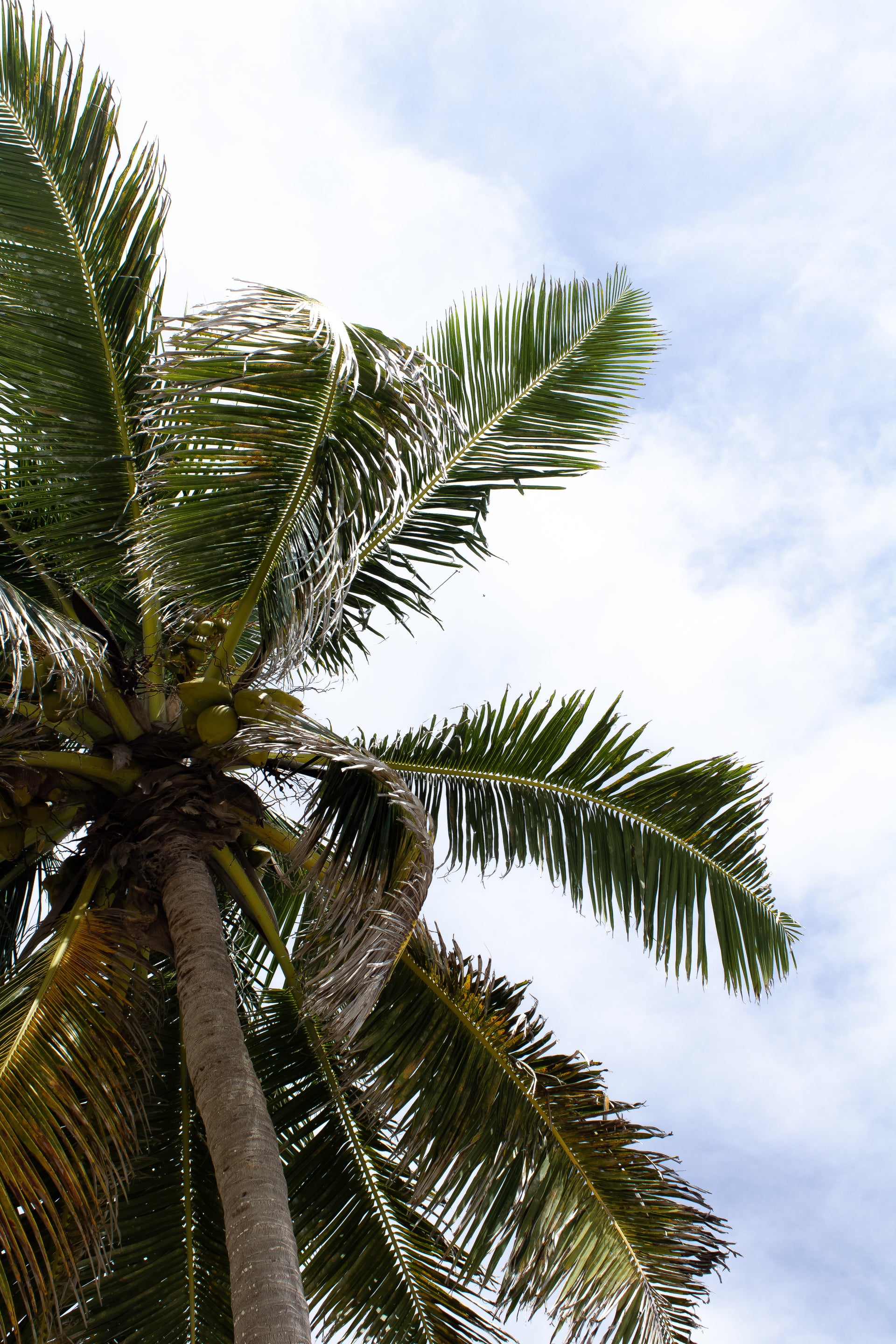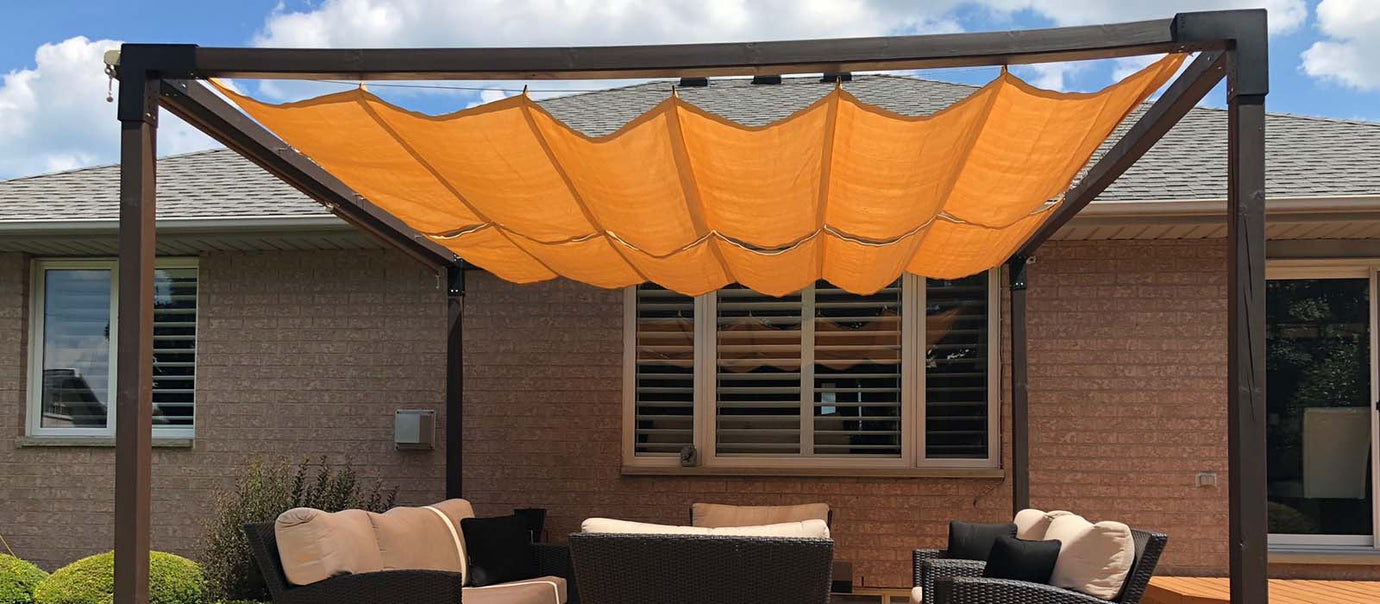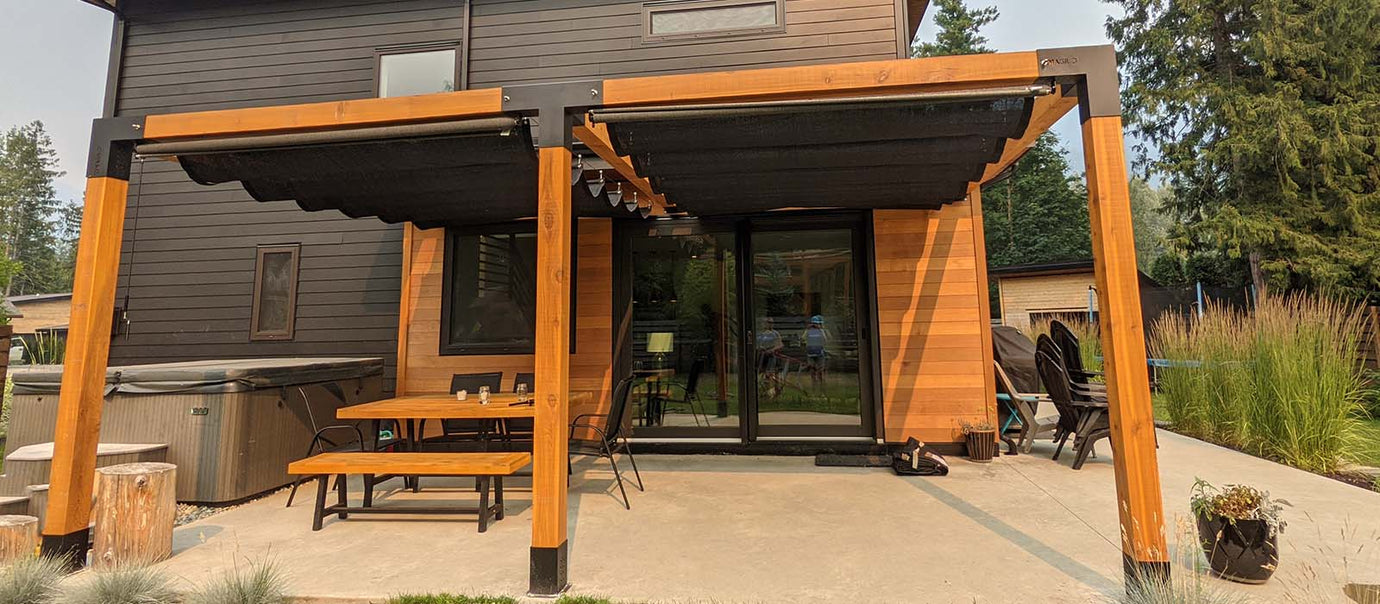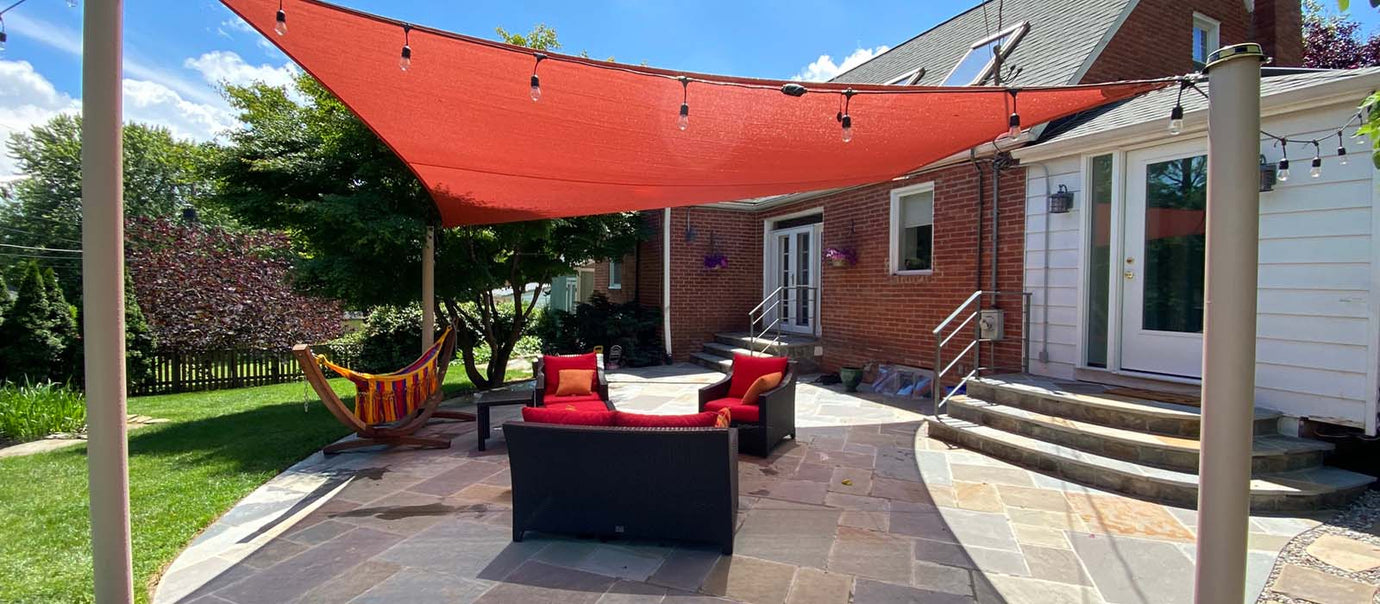Our YouTube channel includes detailed installation guides, frequently asked questions, product overviews and lots more. We are always open to content ideas so please let us know if there is a topic you would like us to cover.
How to Install a Shade Sail

Making sure your shade sail is installed properly is essential to ensuring its aesthetic and longevity. Incorrectly installing a shade sail can also lead to a reduction in performance, especially in inclement weather conditions. At Shade Sails Canada, we sell both custom-sized shade sails and standard sized shade sails.
Download the installation guide PDF (custom shade sail)
Contents
- Customs vs Standards
- Tools You Will Need
- Pulley System Overview
- How to Install Your Shade Sail
- Inspect the Shade Sail and Hardware
- Installing the First Corners
- Using the Pulley System
- Tightening the Cable Perimeter
- Tightening the Turnbuckles
- How to Take Down Your Shade Sail
- Unclipping the Shade Sail From the Anchor Points
- Storing the Shade Sail
Customs vs Standards
While the process is almost identical for both, there are some key differences between the two that you should know about before preparing to install your shade sail.
Labels - If you have purchased a custom-sized shade sail, we will have manufactured your sail to fit your anchor points exactly. In this case, each corner will have a label on it indicating which anchor point it should be attached to. If you have purchased a standard-sized shade sail, the corners will not have labels on them and you can orientate the shade sail as you need to in order to fit your space.
Corner Types - Standard-sized shade sails have a continuously cabled perimeter that terminates at one corner only. The perimeter in a custom-sized shade sail terminates at each corner, allowing you to tension each side individually, leading to more consistent tensioning and better performance. For the installation of your shade sail, this means the cable clamps will need to be secured at every corner for a custom-sized shade sail but only one corner for a standard-sized shade sail.
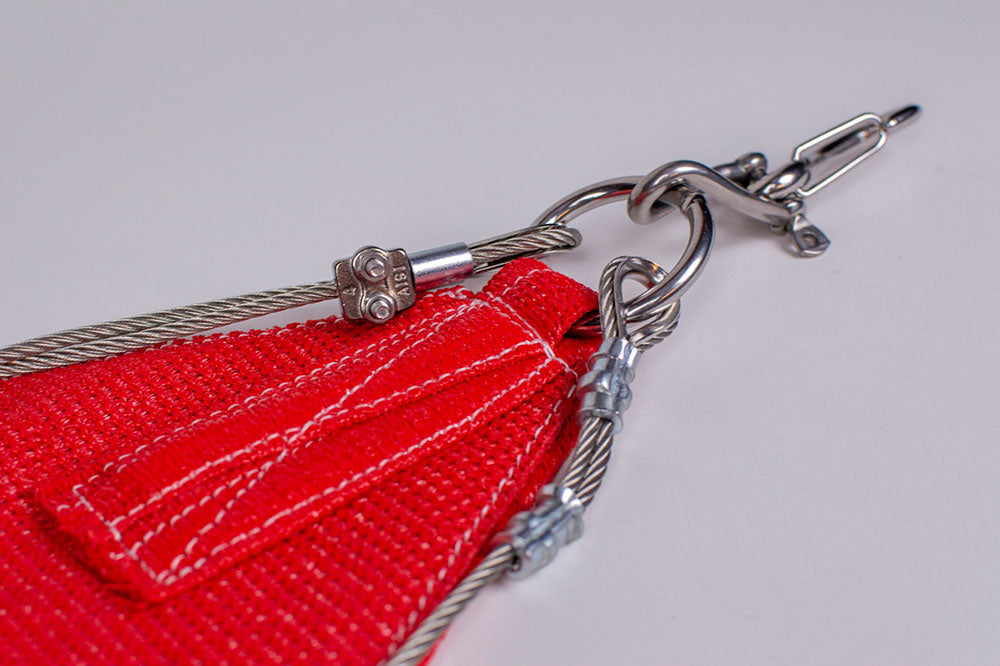
Tools You Will Need
Installing your shade sail does not require a large amount of equipment, however, there are a few items required to ensure all of your hardware is tightened properly.
- Adjustable Width Pliers - these are needed to secure your turnbuckles and tighten your cable clamps. You will only need a small pair of pliers as the nuts for both the cable clamps and the turnbuckles are less than 1cm in diameter. Turnbuckles can be tightened by hand but the cable clamps cannot.
- Stitching Awl - Each turnbuckle has a small hole in the middle that allows you to apply leverage when tightening. We recommend using an awl to tighten your turnbuckles; vice grip pliers will not have enough grip on the body of the turnbuckle and can also leave marks, which are unsightly.
- A Helper - Installing a shade sail is easier and safer with two people, however, it is possible to do it alone if you are careful.
- A Ladder - Depending on your setup, it is almost certain that you will need a ladder for most of your anchor points. Using a sturdy ladder is important to ensuring your safety while you install your shade sail
Pulley System Overview
Installing the final corner of your shade sail should be impossible to do by hand. If you are able to clip your final corner to its anchor point without using a pulley system, you will not be able to apply enough tension with the turnbuckle to correctly fly the sail. Sails flown without the correct amount of tension will suffer from a reduction in performance and aesthetic quality. Each shade sail comes with a length of rope to be used to easily install the last corner of the shade sail, we will cover this in more detail later on.

How to Install Your Shade Sail
Inspect the Shade Sail and Hardware
Whether you are receiving your shade sail for the first time or taking it out from storage, it is important to inspect both the shade sail itself and the hardware to check for any damage caused during storage or transit and that none of your hardware is ceased or damaged.
First, fold your shade sail out onto a flat surface and inspect the fabric; check the fabric is clean and that there are no frays or tears. Then, go from corner to corner ensuring all of your hardware is present and in good working order. While you are doing this, make sure everything is loose; make sure your turnbuckles are fully open, that your cable clamps are undone and that your cable perimeter has slack in each side. Each of these items is much easier to check on the ground and will make installing your shade sail much easier.
Please Note - When folding your shade sail out, especially with certain colours, you will notice that there are creases or fold marks, don’t be alarmed, these will disappear with proper tensioning once your shade sail is flown.

Installing the First Corners
Depending on the size and shape of your shade sail, some corners will have turnbuckles and some corners will not. It is important to attach one of the corners will a turnbuckle last, this will make it easier to apply final tensioning. To begin flying your shade sail, it is easiest to start with the highest corners first.
Attach your first clip to the first attachment point, don’t worry about tensioning your turnbuckles at this stage, this will be done later on once all of the corners are clipped on. Attach each corner until you have one corner left—as mentioned, this should be one of the corners with a turnbuckle—at this point, we will need to use the pulley system to attach your final corner.

Using the Pulley System
A pulley system works by multiplying the force applied from one end to another, making it easier, in this case, to pull the final corner of your shade sail to your anchor point.
Attach one end of the rope to your corner; it is important to make sure the rope is tied to the steel ring itself and not the perimeter cable. You can either use a reef knot or a double regular knot to secure the rope tightly.
Once you have attached your rope to the corner of the shade sail, feed the rope through the eye of the anchor point and back through the corner; you can do this several times, the more times you loop the rope, the easier it will be to pull the corner to the attachment point.
Slowly pull on the rope until the kwik clip is over the eye of the anchor point, attach the kwik clip to the anchor point and then unfeed and untie the rope from the corner.

Tightening the Cable Perimeter
Once all of your clips are fastened to their anchor points, the next stage is to tighten your cable perimeter. If you are installing a standard shade sail, this will need to be done at one corner, if you are installing a custom shade sail, this will need to be done at each corner. Each loop of cable has a thimble that prevents it from rubbing on the ring; before tightening the perimeter cable, ensure the cable runs over the thimble instead of resting directly on the steel ring—please see the diagram below.
Use one hand to pull the perimeter cable and one hand to adjust the position of the cable clamp. The perimeter of the sail should be tight but not so tight that the seam starts to pucker. Once you start to see the seam puckering, back off a little bit so the full length of the seam is smooth. Once you have the perfect amount of tension, slide the cable clamp snug to the thimble and use your adjustable width pliers to tighten the bolts.
Please Note - Do not overtighten the bolts as they will cease and prevent you from loosening the cable clamps when you take down your shade sail at the end of the season.
Once you have tightened the cable clamps, feed the rest of the cable into the seam. Repeat this at each corner.

Tightening the Turnbuckles
The final step to installing your shade sail is to tighten your turnbuckles. Turnbuckles should be lubricated every year using the lithium grease supplied with your shade sail to prevent ceasing.
We suggest tightening your turnbuckles with an awl, this gives you good leverage and enables you to secure the turnbuckles tightly. Insert the awl into the through-hole in your turnbuckle and pass it from hand and hand as you tighten the turnbuckle.
Once you have finished tightening with the awl, you will notice there are two nuts on either side of the shade turnbuckle; these prevent the turnbuckle from wriggling loose during the season. The nuts can be done up with your fingers but we suggest applying final tensioning with your adjustable width pliers.
We recommend alternating between tightening the turnbuckle with the awl and the nuts with your fingers to ensure everything is nice and tight. If you have multiple corners with turnbuckles—triangle shade sails will only have one corner with a turnbuckle—tighten the turnbuckle on the opposite side of your shade sail in the same fashion, this is the final step in flying your shade sail.
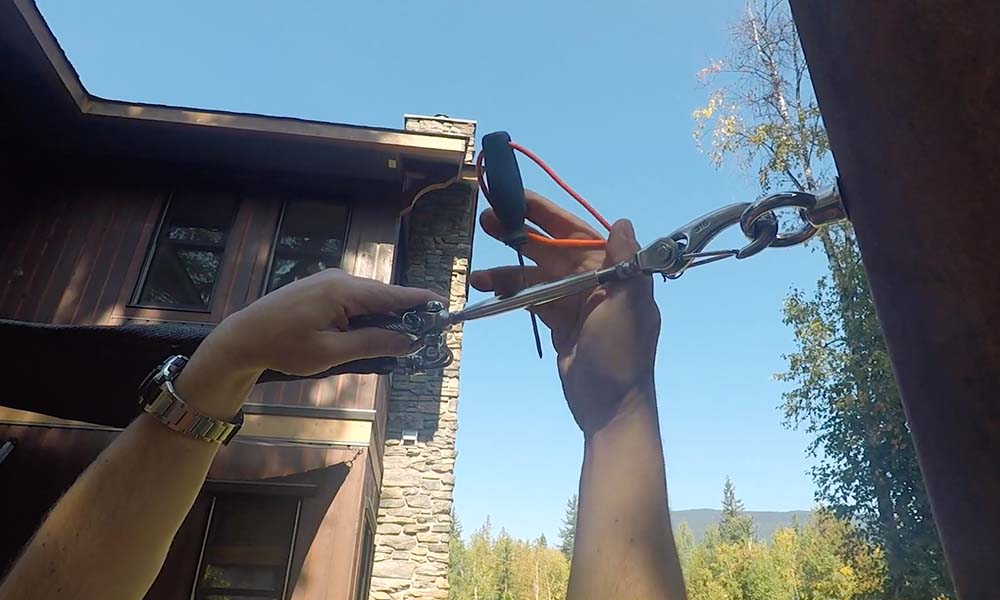
How to Take Down Your Shade Sail
Unclipping the Shade Sail From the Anchor Points
Labelling - Before we discuss how to take down your shade sail, please bear in mind—especially if your shade sail is a complicated shape—it will much easier to put up again in spring if each corner is labelled to correspond with the anchor point. As such, we recommend labelling each corner as you take it down.
Taking down your shade sail is a very similar process, although slightly easier. Start by loosening your turnbuckles; loosen the nuts with your adjustable width pliers if you can’t do so by hand and then use your awl to loosen them fully. Remember to loosen almost all the way to the end of the tread, this will make it much easier to install your shade sail again in the spring. Once your turnbuckles are loose, go around each corner of your shade sail and unclip.
Please Be Aware - Once the first couple of corners are unclipped, the final few corners can become quite heavy with the full weight of the shade sail. If in doubt, please use a friend or family member to assist.

Storing the Shade Sail
The final step is to ensure your shade sail is stored correctly. You can do this by folding your shade sail from side to side until it is small enough to roll it up into a bundle. On each fold, check there are no twigs or anything else that could damage your shade sail during storage.
Before rolling your shade sail into a bundle, ensure all of the hardware corners are folded in properly and then roll your shade sail from one end to the other, again, making sure there are no twigs or other debris caught up in the shade sail. You can then store this in your winter storage bag if you purchased one or any other kind of sturdy bag that will prevent damage when storing your shade sail.

FAQ: Installing Your Shade Sail
How long does it take to install a shade sail?
Most installations can be completed in a few hours, depending on the size and number of sails. Larger or multi-sail setups may take longer.
Can I install a shade sail by myself?
While it’s possible, having a second person helps ensure safety and makes tensioning the sail easier, especially for larger models.
How tight should my shade sail be?
The fabric should be firm and wrinkle-free but not overstressed. Over-tightening can strain hardware, while loose sails may flap in the wind.
Do I need to remove my shade sail in winter?
Yes, we recommend taking your shade sail down during winter or severe weather. Proper seasonal storage helps prevent wear and prolongs its lifespan.
Conclusion
Proper installation is the key to ensuring your shade sail performs beautifully and lasts for years. By following each step carefully—from tightening turnbuckles to storing your sail correctly—you’ll protect your investment and maintain both its tension and appearance season after season.
Whether you’re installing a standard or custom shade sail, taking the time to do it right ensures lasting durability, safety, and stunning results.
